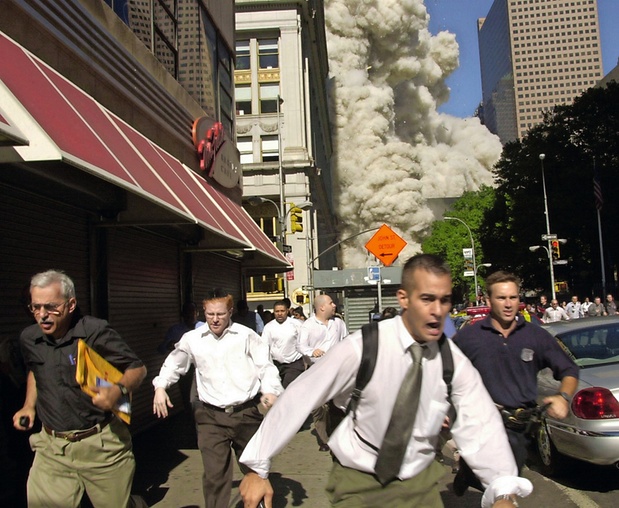Joe Massian The Guardian
I was in the North Tower when the first plane hit. I arrived at my desk on floor 70 at about 8.30am, but before I’d sat down I felt the building sway. I grabbed the top of my cubicle wall to steady myself. That was followed by the noise. I thought it was a construction accident somewhere in the tower.
I headed for the stairs, but there was already a long queue of people. One colleague was in shock and needed help getting down. At one point, a firefighter asked me where the water coolers were on my floor – they were giving dehydrated people drinks, then pushing them on. Occasionally people would shout, “Move right” to let people pass who were badly burned or injured. There was no phone signal, but people with two-way pagers were getting messages, and we learned that the South Tower had been hit.

Joe Massian, pictured front: ‘My fiancee knew I was alive, as this photo was one of the first to be posted online.’ Photograph: Suzanne Plunkett/AP
At the bottom, there was a human chain of firefighters, FBI and police guiding people through the lobby: the plane had hit the North Tower in the middle and there was debris on all sides, so the mall below was our only exit. The lobby was covered in debris, windows had been blown out, and fires were burning. Outside, I looked up at the towers; I heard a pop, like a controlled explosion or a firework. The South Tower was collapsing, so I started to run.
I didn’t know if it was going to fall down straight, like a domino, or sideways, so I zigzagged away – left a block, up a block – heading uptown towards the Brooklyn Bridge. That’s when this photograph was taken, with me front and centre. That time is a void: science channels talk about impending death as comforting, and I felt that. Calm and peaceful. Then I thought, “Hey, I’m not going to die today.” My senses returned and I felt anxiety and pressure to survive.
I got to the Brooklyn Bridge, and my mum rang. She kept saying. “Are you OK? Are you alive?” And I said, “Of course I’m alive: I’m talking to you.” While I was on the phone, the North Tower collapsed. Aside from the fire engines, it was weirdly quiet: no one yelling, just people in tears, on their phones, covering their mouths.
This was one of the first images posted online: that’s how family and friends learned I was OK. It was widely used in newspapers, and it has been on TV, in magazines – it’s even on display at the 9/11 museum in New York. It’s not my most flattering picture.
It’s humbling to have been part of such an extraordinary event, and to have that captured. I wrote to Suzanne, the photographer, to say how much her picture had affected my life. It has kept me grounded: it’s a solid reminder that you do get second chances. When I look at it, I can hear, see and feel everything again. It puts me right back there.

